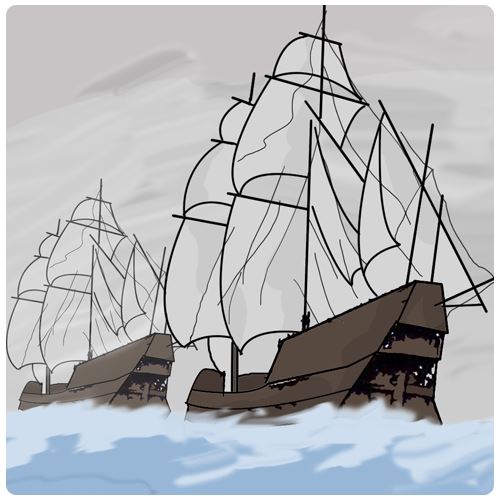Audience: KS3/4
Subject: RE
Topic: Christianity, Jesus, Easter, Crucifixion, Bible
Question: Why is Jesus crucifixion significant?
Author: Jonny Greenshields
Description
This mystery challenges learners to look across different Biblical writings concerning the crucifixion to answer the question 'Why is the crucifixion of Jesus significant?'
To give a full answer to the question, students will have to build their argument using quotes from the Old Testament and New Testament as well as their own ideas.
The task has three difficulty levels - on easy, students are given 14 slips, on medium, 18 and hard, 20. These include quotes from the Bible as well as statements around the topic to help students understand.
This mystery can be used to help students understand the differences between the perspectives of the Old and New Testaments on the crucifixion of Jesus.
Subject: RE
Topic: Christianity
Question: Why are miracle stories an important feature of Mark’s Gospel?
Author: Jonny Greenshields
Description
Based on a knowledge of the following miracle stories from Mark’s Gospel (Feeding of the 5000, Healing of Legion, Calming of the Storm, Walking on Water, Raising of Jairus’ Daughter) this mystery challenges students to infer what each of the stories suggest about Jesus' identity. As well as this, students will need to consider what different interpretations of miracle exist and how they apply to the stories.
- Match up slips to the different miracle stories: Feeding of the 5000, Healing of Legion, Calming of the Storm, Walking on Water, Raising of Jairus’ Daughter
- Discuss, debate and think about what each of the stories suggest about Jesus' identity
- Consider and discuss the different interpretations that exist
Audience: KS3
Subject: PSHE, Politics
Topic: Elections, debate, Conservatives, Labour, Liberal Democrats, UKIP
Question: Where should Grace Feng put her cross on May 7th and why?
Author: David Leat
Description
The big goal of this mystery is to get young people more aware of and interested in politics and the 2015 UK general election. It has been created with support from Newcastle University in order to achieve this.
There is considerable evidence that the number and percentage of the population who actually vote in elections is falling. Pundits variously blame apathy, distrust of politicians, the death of big ideas in politics and the decline of local government (to which people may feel more connected). However, democracies only have legitimacy if people vote, or at the very least, deliberately spoil their ballot papers.
Generally, more older people (the grey vote) vote in elections and in the last 5 years the incomes of older people have not been reduced nearly as much as young people. If young people don’t vote, they are much more likely to be ignored by politicians and lose out.
The question that the pupils should address in this mystery is NOT ‘Who would YOU vote for?’ but ‘Who do you think Grace should vote for? And why?’
It is hoped that many students will be sufficiently interested to do some research of their own on the parties’ policies. You may want to direct this yourself.
The information provided is intended to be reasonably balanced and some of it may not be entirely accurate as much of it is what friends and relatives are telling Grace, and each other. You should stress to your students that they should focus on the slips that say something about the character and values of Grace, and this should help them make their decision.
The intended learning outcomes are:
1. To understand some basic points about the policies and track records of major political parties in England.
2. To listen carefully to other people in their group and to other groups.
3. To make a reasoned decision (using evidence) about how Grace will vote.
4. To critique other groups’ decisions (using evidence) and defend their own decision as appropriate.
5. To explore more detail of the election policies of any of the political parties.
Audience: KS3/KS4
Subject: Media
Topic: Film Festival, Audience, Genres, Education, Marketing, Industry
Question: Which film would be suitable for Mr. Spine to show at the next ‘Film Evening’ and why?
Author: Elizabeth Doyle
Description
This resource is designed to help students apply their knowledge of the concept of target audience and demographics. They do this through the scenario of Mr. Spine who lives in a village called Chugley and runs the local film club. Students are asked to help him decide on a suitable film for the other residents.
It is hoped that this will help students to identify the different factors, such as income, education and age that are taken into account by the marketing industry, and consider how these things could influence a decision-making process such as this.
Before the students are introduced to the material, a homework task could be set to ask them to compile a broad list of films of various genres and types. They could form the basis of their choice as they would then be able to discuss and comment upon these in class. If more research is needed, the class could have online access to resources such as IMDB.
As well as the main question, there are additional sub-questions suggested which help students break down the task or encourage them to think about specific points.
Easy difficulty level - in the most basic form, students are given a lot of information on the village of Chugley including the age and occupations of some residents. This is so they can assess what demographics they are, then discuss and match up suitable film choices.
Medium difficulty level - additional slips are included to help students focus on the economic profile of the people of the village, and its appearance as a very ‘up-market’ place, although with a sizeable number of people on an average income. They could be encouraged to ask what assumptions could be made about the tastes and habits of wealthier people.
Hard difficulty level - the brightest students may want to extend their consideration to the possible political views of the population, and whether this would suggest a more ‘liberal’ audience or a more ‘cautious/conservative (with a small ‘c’)’ one.
Subject: Maths
Topic: Mental methods addition, subtraction, multiplication, division, comparing, calculations
Question: Who killed King Ted?
Author: Anne de A’Echevarria
Description
Who Killed King Ted? is a typical 'whodunnit' complete with suspects, motives and a possible twist - was King Ted, in fact, killed at all?!
Although the mental arithmetic involved requires precision, the task is open minded and provides scope for pupils to come up with and justify more than one possible solution.
The mystery involves mathematical concepts such as capacity, time, distance and speed, and could be used diagnostically within the maths curriculum to assess pupils' confidence in recognising and applying these concepts.
Key learning objectives might include:
- to practise mental methods in addition, subtraction, multiplication and division in order to solve the problem, deciding which operations and methods to use
- to compare and calculate different measures, involving: money in pounds and pence, capacity (ml), and distance over time (mph).
Audience: KS2
Subject: Maths
Topic: Addition, subtraction, multiplication, division, multi-step problem, averages
Question: Should Trev hire the new machine or stick with the old one?
Author: Anne de A’Echevarria
Description
Trev is the boss of a Robot Packing Factory on planet Triffen. He has been having some trouble with his Robot Packing Machine and decides to compare its profitability with that of a brand new one. He’s finding the calculations a little tricky, so KS2 Maths students are invited to help him out. The problem involves addition, subtraction, multiplication and division, including the calculation of averages. The reliability of statistics and data can also be considered.
While students must make accurate calculations and solve multi-step maths problems, the answer to Trev’s problem is open-ended.
‘Trev the Triff’ could be used diagnostically within the maths curriculum to assess pupils’ ability to decide which operations and methods they need to use to solve a multi-step problem, as well as their confidence in working together to explore and justify their ideas.
At each level (basic, standard, advanced) an added cost to Trev is brought in. For example, in the medium set of slips, students are introduced to the fact that the machines need staff to operate them. Although these extra considerations allow differentiation and therefore change the overall numbers involved, what the students’ decision is based on doesn’t change. This means the whole class can still be engaged in the same story together.
Depending on abilities, and which level is chosen, we recommend that this mystery can be used with Year Five but also top set Year Four.
Original images of 'Triffs' come from www.awaywiththepixels.com
- To solve a multi-step problem, deciding which operations and methods to use and why;
- To add and subtract numbers up to 4 digits either mentally or using a written method;
- To use place value, known and derived facts to multiply and divide mentally, including dividing by 10, multiplying together three numbers, and calculating averages.
Audience: KS2
Subject: Maths
Topic: Addition, subtraction, multiplication, division, fractions, percentages, statistics, measurement
Question: Did Captain Quint and his crew make it round the world in 50 days?
Author: Anne de A’Echevarria
Description
This mystery maps to the maths curriculum. Specifically:
- Number – addition and subtraction
- Number – multiplication and division
- Number – fractions (including percentages)
- Statistics
- Measurement
Although the calculation involved in Captain Quint requires precision, the task is open-ended and provides scope for pupils to come up with and justify more than one possible scenario.
The mystery will challenge pupils to decide and justify to each other, which operations and methods they need to use to solve a multistep problem. As well as addition, subtraction, multiplication and division, some calculations also involve fractions and knowledge of percentage and fraction equivalents. Pupils will need to interpret information in tables, graphs and maps and be able to compare and calculate different measures, involving capacity and distance over time.
It could be used diagnostically within the maths curriculum to assess pupils’ confidence in recognising and applying these concepts.
There are three difficulty levels to this mystery. Easy has 20 slips, medium has 25 slips and hard has 26. As a guide, we suggest it is most suitable for 10-11 year olds.
Learning outcomes:
- To add and subtract numbers both mentally or with a calculator (as appropriate); to multiply and divide numbers up to 4 digits by one- or two-digit numbers using a formal written method, calculator or mentally (as appropriate) – all within a multi-step problem, deciding which operations and methods to use and why.
- To multiply proper fractions by whole numbers; use knowledge of percentage and fraction equivalents.
- To read and interpret information in tables and graphs including calculating and interpreting the mean as an average.
- To compare and calculate different measures, involving capacity (ml), and distance over time (mph/knots).rate their own unique, yet easy to remember passwords
Audience: KS4
Subject: History
Topic: US History, Law, Society, Economy, Politics
Question: Why was Prohibition felt to be necessary in The USA in 1919, and then repealed in 1933?
Author: Elizabeth Doyle
Description
This mystery explores the reasons for the introduction of Prohibition in the USA in 1919, and its eventual repeal. It is intended to support studies of the 14-16 age range – including controlled assessment – of the USA in the inter-war years, and raise themes including social reform, economic and political pressure and the question of Federal Government as opposed to State legislation and local practice and circumstances for the more able student.
It is important that students understand why two such opposing arguments relating to the question of the legality of alcohol could be so compelling to their respective supporters, and have a clear understanding of the circumstances in which this debate had taken place. Once the historical context and specific conditions in which the law was passed are understood, the more able may then be in a stronger position to relate the issues to the present day, and current debates about the legalisation of banned substances.
There are 14 slips of information in the basic level of the mystery (the app starts by default in ‘medium’, but this can be changed at any time in the settings). There are 22 slips on 'medium'; the additional slips require more able students to consider the ‘grey areas’ around the issue, i.e. the failure of the authorities to enforce the law, and the complicity of ordinary Americans who continued to consume alcohol, and ‘turn a blind eye’ to illegality. Also, the public’s fondness for alcohol could not be ignored. On the ‘hard’ setting, there are 26 slips (an extra four). The most able students should be able to link the tensions and issues raised by the attempt to stop the consumption of alcohol to other debates about the state control of illegal substances. They are also designed to raise the possibility of tax revenue for the government, and set this against the question of the health and welfare of the population.
While students complete this task, they are propelled into this important era in history. It supports their studies of this time and helps them learn about, and discuss, various themes.
Depending on level of knowledge or ability, the task can be suited to different students.
Audience: KS4/KS5
Subject: History
Topic: America, Literature, 20th Century, Racism, Industry, Media, Community
Question: Were the ‘Roaring Twenties’ a good time to be alive in America?
Author: Elizabeth Doyle
Description
This resource is intended to help students engage with the various experiences of Americans who lived during the period known as ‘The Roaring Twenties’. It is hoped that they will discover that while there was prosperity and increased opportunity for some, others missed out on some of the new opportunities. In addition, to learn that while some women experienced changes, others belonged to communities that resisted innovation, and that racial discrimination continued to be an issue.
In America, the 1920s was a time of social change and upheaval. It is important that students who are studying American History have an overview of the more significant aspects of the changes, and their effects. This mystery is intended to help students achieve such an overview, and link this to their understanding of related topics such as race, industrial relations, family life and the role of women in Twentieth Century America. Because the subject of mass media and communication is a major feature of the period, more able students may be able to trace the influence of technology and the accessibility to information, opportunity and ideas during this century. There may also be opportunities for cross-curricular discussion relating to Media Studies or the Media elements in English Language.
It could also provide a good background for those studying ‘The Great Gatsby”, as it gives key historical context for an exploration of the novel.
There are three difficulty levels to this mystery. On Easy, there are 18 slips, Medium, 24, and Hard, 28. The Grouping Stage introduction is also slightly different for each difficulty level - with the focus solely being on the most notable features in Easy, the impact of different innovations in Medium and the effects of the Roaring Twenties on various economies/experiences of different groups, in Hard.
Medium difficulty level: This set is intended to help students explore the ways that the ‘Roaring Twenties’ impacted on the different parts of America, women and Black Americans. There was a range of change and innovation at this time, and the effects of these varied across the country and in different social groups. Whether the innovations of the period were feared or embraced often depended upon the outlook and perspective of the people concerned, so there is a discussion to be had as to whether the 1920s were a positive or a negative decade for the USA.
Hard difficulty level: The more able students may be able to identify the long-term impact of the 1920s, and the legacy that was created, for example, by the emergence and popularity of mass consumerism and the dissemination of Black culture. There is also a literary legacy, epitomised by the life and work of F. Scott Fitzgerald, which is best understood when studied in the context of this remarkable period in American history.
Some suggested goals for this task, depending on ability or level of knowledge may be to:
- discover the differences in opportunities for many people in 'The Roaring Twenties'
- develop an understanding/overview of the changes during this period and their effects
- link the changes to their understanding of related topics, e.g. race, industrial relations, family, women

Audience: KS3
Subject: History
Topic: Spanish History, Naval Warfare, Tudors, Religion, Christianity
Question: Why did Philip II of Spain decide to launch an armada of ships to invade England, and would he be sorry he did so?
Author: Paul Lawrence
Description
The Spanish Armada is a significant event during the Tudor period, and one which sheds light upon a number of key themes that emerge during the study of ‘The Making of the UK’. These include Catholic and Protestant religion, power, warfare, international politics and questions of succession to the throne. It is also an event whose outcome could not have been predicted, but provides a good opportunity for students in Key Stage Three to consider a range of factors and evaluate the contribution each event or combination of events makes to the ultimate failure of Philip of Spain’s campaign.
While the students using the basic set are asked to identify the reasons for the launch of the Armada and its outcome, the standard set of statements are intended to assist students in the skills of evaluation, and the assessment of the importance of religious conflict as a cause of the venture. More able students could then consider how much the planning and tactics of those involved were undermined by forces beyond human control. It is hoped that this will help to develop the higher-order strategies of analysis and evaluation that will lead to success in Key Stage Four.









